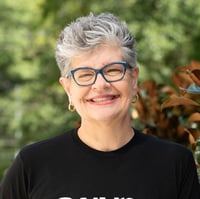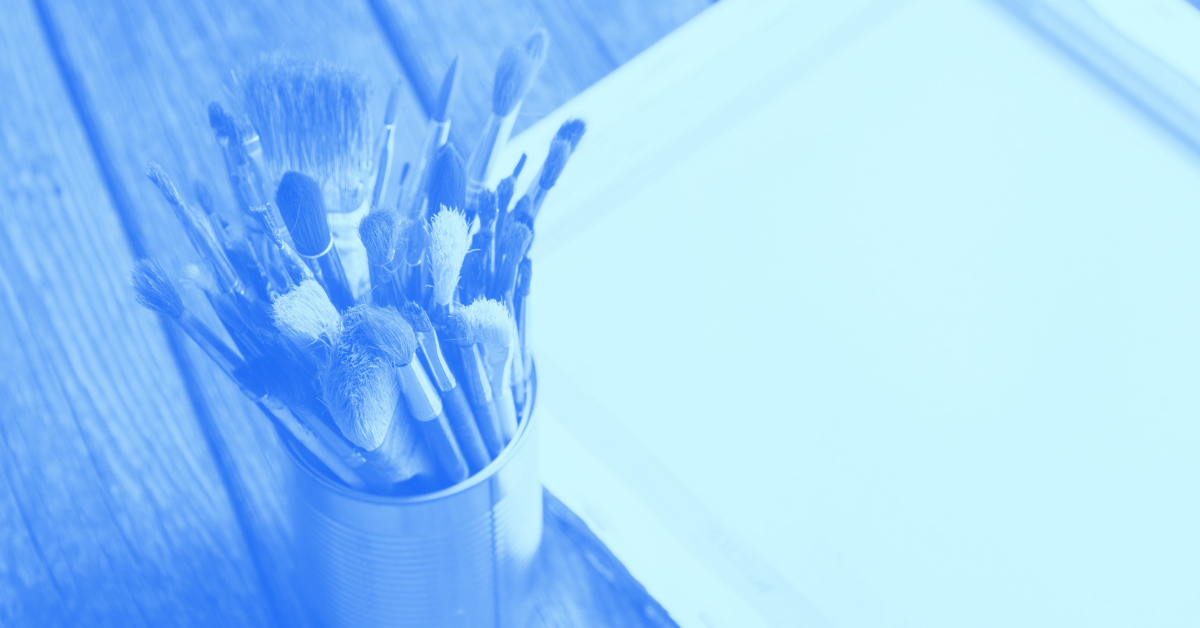Practicing a Creative Day: What Would Arlene Say?
Share this
The XY Planning Network team has been trying something new the last few months. One day a month, each of our team members has been taking off to practice a “creative day.” I wanted to review how this process has looked for me, and how I think it could positively impact your planning practice.
Let’s get real about creative days. When I first got started with them, I was terrified. The idea of having a full day to just “be creative” seemed overwhelming, exciting, and scary all at the same time. I had an expectation that my creative day would end with long lists of new ideas, each one as amazing as the last. But the second I started expecting myself to be innovative and marvelous, I felt anything but. As my first creative day crept closer on the calendar, I was jittery with nerves.
Nerves aside, I now have two (soon to be three) creative days under my belt. The positive impact they’ve had on my team and the way I view my work in general has been incredible. I never could have imagined that these creative days would go so well, and practicing them regularly got me thinking:
How often do financial planners give themselves space to be creative?
How often do my clients set time aside to brainstorm, work on their business, or create something new to push themselves to the next level?
I immediately knew the answer to these questions. Most planners and business owners I know don’t have enough hours in the day to keep up with working in their business, much less dedicate a full day to creative thinking.
In fact, I bet some people reading this right now are rolling their eyes and thinking about their endless to-do lists. But taking time for creativity is critical to increased productivity, forming better ideas, and implementing new solutions that will help you grow your financial planning practice. So, before you start shrugging off this idea as something that won’t work, let’s walk through how my first two creative days went, and how you can set yours up for optimal results.
First Impressions
When I started to plan out time for my inaugural creative day, I let the endless opportunities stress me out. Having an open-ended plan seemed crazy. How in the world would I actually be productive if I didn’t have a list of action items I wanted to accomplish? Wasn’t I running the risk of hanging out in my jammies all day, drinking lots of coffee, and claiming that the one page of pie-in-the-sky ideas I came up with was me being “creative?”
Honestly, I think this was the key misunderstanding I had about the creative day concept when I got started. I thought that the backbone of creativity was a lack of structure. This isn’t true! To be truly creative, you need to find what environment works best for you—for some people, that’s an unstructured environment, for others, it’s not. For me, finding a balance between a structured day of creativity and leaving myself room to work on something that came to me in the moment works best.
I finally settled on blocking out a specific amount of time for my creative day. I decided I’d pack a notebook and my laptop and head to my home away from home—the Starbucks near my house.
Results of My First Creative Day
My favorite Starbucks store manager, Katie, knew exactly what I was up to when I walked through the door on my first creative day. I had asked her to hold me accountable (even if that meant yelling at me when I tried to answer the phone or check my email). Katie’s awesome and had prepared my favorite caffeinated beverage to jump-start my creative day. In hindsight, maybe she was more ready for my day of creativity than I was.
The only idea I had to work on was a handful of blog post outlines I had in the works—definitely not enough to get me through the full day. Still, I powered through. And let me tell you, it was amazing.
At first, I struggled to get into a good groove. I kept reaching for my phone to check emails (cue Katie’s yelling), and had to perpetually stop myself from getting caught up in my typical work “to-dos.” I kept worrying about the outcome of the day. Part of my worry was that taking the results of my creative day back to a team for further review would highlight how much I actually stink at being creative. Finally (after the second cup of coffee) I hit my stride. I was working on notes for a blog post when it hit me: I wanted to write out a new creative program for XY Planning Network.
This idea had been something I’d tinkered with before, but had never made any true headway on. As soon as it dawned on me that I had a full, uninterrupted day just to outline that idea, I was off to the races. I burned through a massive chunk of my notebook. My hand actually cramped because I was writing so much! It was an incredible feeling to create something that had been in the back of my mind for a while. Watching it come to life on the pages of my notebook was surreal and I was excited to take it back to the team for review. Gone was my nervousness about being viewed as a creative flop.
The Takeaway: As soon as I let go of an outcome-focused perspective, the creative energy started flowing.
If this is something you struggle with, I suggest you check any expectations you have at the door before starting your creative day. Don’t assume you’re going to check something big off your to-do list. Don’t assume a bolt of inspiration will strike and you’ll totally revamp your business in a new, innovative way. Instead, simply give yourself the room to brainstorm, think, and take a step away from client-facing tasks. It’s amazing the doors that can open when you kick your expectations to the curb.
Results from My Second Creative Day
Guess what? My second creative day was more nerve-wracking than the first! You’d think I’d have shaken my misgivings after the first one was such a success. Turns out, that was exactly the problem! I had made so much progress on such a big concept on Day 1, that I felt pressure to do the same on Day 2. Expectations like this undoubtedly hinder creativity, so do your best to push them from your mind.
Just like with my first creative day, it took some time to get into the swing of things. I decided that taking a walk might help me get into a creative headspace. Less than 10 minutes into a walk on a beautiful, local trail I was checking my watch. “Why am I not creative yet?” I asked myself. That’s when I realized that I was standing in the way of my own creativity, once again, by putting the same pressure on myself that I had sworn off after my first creative day. You know what they say about old habits…
I had assumed that because Day 1 was so focused on creating content, that Day 2 would have a similar outcome. And I was wrong! That was not the headspace I was in at all. Instead, my attention kept returning to business processes. That’s the thing about creativity—you’re never sure where it’s going to take you, but you should always give yourself the space and freedom to find out.
Finally I caved and started recording my ramblings while on my walk. I talked through different systems I use, and that my team uses, and how we can better collaborate and increase communication across all departments. I thought through how I work with clients and how I might improve those interactions. I even talked through my worry that my coworkers would judge me for having a “meh” creative day in comparison to my last one.
Did I look like a crazy person talking into their headphones while walking down the trail? You bet. Did it help to have those recordings to look back on later? Absolutely.
On Day 2, I had a scheduling conflict that I couldn’t move, forcing me to “split” my creativity into morning and afternoon to accommodate an appointment. This was an interesting experiment in whether or not I could feasibly turn my creativity off and on. Turns out transitions are tricky. I struggled to get out of the creative mindset when I had to change tasks, and I couldn’t get back into a good flow when I had to pick it back up again. Lesson learned.
Ultimately, I didn’t feel as good about Day 2, but I did learn something important about how my creativity is best accessed, and its limitations.
The Takeaway: Even though this creative day was notably less “productive” than my previous one, I still count it as a win. I learned that I struggle to transition in and out of creative thinking. I also learned that sometimes I need to give myself the space to not be creative, but rather just be me. I tell my clients all day, every day to be themselves and embrace systems that work for them, but when it came time to practice what I preach, I fell flat on my face and burdened myself with heavy expectations.
Lessons Learned
With just two creative days under my belt, I’ve already learned a lot about how to pull them off successfully. As a coach for financial planners, I firmly believe that being honest about my experiences and letting my clients learn from my mistakes is one of the biggest ways I can help people. That being said, here are the biggest lessons I learned from my first two cracks at a creative day:
Protect Your Time
I’m so good at protecting my time in other areas of my work and life that it blew my mind when I failed to protect my second creative day in the same way. I let other appointments and meetings outrank the day, and it completely messed up my flow. When you’re scheduling a creative day—or even a creative afternoon—don’t let anything else take precedence. Being creative is just as important as answering a client email. In fact, it might be even more important for long-term business success and personal fulfillment as a business owner.
We often feel that it’s important to be available all the time. That just isn’t the case. So, do what you have to in order to keep your creative time sacred. Here are a few things that helped me:
- Turn off your phone
- Turn off email notifications
- Use a pen and paper for brainstorming and creation, not your laptop (which is chock-full of social media, messaging, and other distractions)
- Block off this creative time on your scheduler so that clients know you’re unavailable
- Turn on your out-of-office autoresponder
Know Yourself
Self-awareness is the name of the game. I found that a full creative day was a bit much for me. By the end of the afternoon, I was completely zapped and devoid of energy. If this happens to you, maybe try blocking out a few hours for creativity rather than committing to a full day. On the other hand, if you know you’re going to need more than a full day (it’s amazing what can happen once you get in the zone), block out several days to focus on creative pursuits!
I also found that my home office was a total creativity-buster. It was too easy to fall into my old routines. To shake things up, I chose to head to a coffee shop and go for a walk. You may have no issues being creative in your usual space, but if you’re like me, consider finding somewhere you can be freely creative and easily avoid distractions.
Finally, I quickly realized that I had recurring “distractors.” Email doesn’t tend to be a huge distractor for me, but responding to questions on social media and Slack definitely are. I tell myself that it will only take a few seconds and end up spending a half hour talking to people about things that are not urgent. Before you launch your creative day, try to predict what might be a distraction for you and figure out how to minimize it. This will help you stay on track and optimize your time.
Try Something New
“Wait,” you say, “A creative day is something new.” I know! I’m really asking you to step outside of your comfort zone here and try a new way of inspiring creativity. During my second creative day, I opted to try a focus-trick I had recently heard about: I listened to the same song on repeat for the majority of my creative session. Sound crazy? I thought so too—until it worked.
The single song focus acted like muscle memory and inspired me to associate thoughts and memories with the looped lyrics. I had originally tested this theory while skiing and found that I enjoyed my time on the slopes more and improved my performance on the mountain while listening to just one song. This theory held true for my creative day. As soon as I switched to the repetitive song, it’s like my brain kicked into creative mode.
A repeating song might not be for you, but don’t be afraid to test out something new on your creative day like I did. Maybe you try meditation, journaling, or another focus-inspiring activity to help keep you on track. See where it takes you. If it doesn’t work, it’s okay to scrap it and move forward.
Give Yourself Space
On both creative days, I started to beat myself up when I wasn’t creative right out of the gate. As a result, I spent the first valuable chunk of my creative day worrying, which further limited my creativity! Give yourself the space you need to feel whatever it is you’re feeling. Heck, on my first creative day, I wrote in my notebook about how dumb I felt trying to be creative!
Eventually, you’ll find the groove that works for you. Until then, don’t force it. Let things flow. Results will come in their own time.
Track What You’re Thinking
On my first creative day, I wrote notes. On my second creative day, I recorded what I was thinking into my phone. Whatever method you prefer, find a way to track your musings on your creative day. Even if you aren’t actively creating something new, the thoughts you have when you give yourself space to imagine new possibilities for your life and business are important.
If you don’t track your thoughts in any way, you have an increased likelihood of missing something big when you walk away from your creative day, or you’ll struggle to recreate a concept that made so much sense to you in the moment. When you record your thoughts (either through voice or writing), be as descriptive as you can to give your future self some context from which to work.
Have a Plan
Yes, your creative day should be “unstructured” time to create. That doesn’t mean you can’t have a loose plan for how you want the day to go. The system that ended up working best for me was to block out time. Remember to block off time at the end of your day for wrap-up. This might mean jotting down summarizing notes, creating action items to implement your new ideas, or taking time to reflect on the creative energy you spent during your day. This can also help you transition out of your creative headspace and back into reality.
Don’t Pigeonhole Your Creativity
After my first creative day, I assumed my second creative day would be equally focused on creating content for new programs, blog posts, and more. I found that when I got into the creative groove, though, my attention was much more focused on business processes and systems. Both of these things were excellent uses of my time, but they couldn’t be more different from each other.
My point is don’t pigeonhole your creativity. Use your creative day to work on whatever inspires you in the moment. You might consider working on:
- Business processes and systems
- New ways of communication internally and with clients
- Templates (email, blog posts, onboarding)
- Workflows
- Onboarding new team members
- Marketing strategy
- New service offerings
- New pricing schedules
- Ways to get involved in your community
- How you can improve your day-to-day so that it includes doing the things you love
Or you might consider working on something else entirely—and that’s totally fine! These are just some ideas to consider if you’re struggling to get started.
Move Towards Action
Something I noticed during this creativity experiment was a lot of my ideas were high-level. If I was a full-blown business owner, I might struggle to take these creative concepts from the idea phase to implementation. Luckily, I have an incredible team here at XY Planning Network, and we support one another in making our dreams a reality.
However, when speaking with financial planning clients, I find that a lot of business owners get stuck here. As you plan out your creative day, make sure you look at how to put your creative plans into action. To do this, I suggest leaving 30-60 minutes at the end of your day to write out an actionable to-do list and set some goals. Get the tasks necessary to bring your creative vision to life on your calendar and make them happen. It can also be helpful to reach out to a coach, mastermind group, or accountability partner for help staying on track.
Creative days are now officially an integral part of how I work. I love knowing that I can block time out to focus on creativity, new ideas, and improvement. I know that as a financial planner it can be difficult to step away from your business to look at the big picture, so when you get started with creative days, be gentle with yourself. Try doing something you love, like hiking, walking, or sitting down with a cup of coffee, to get into a creative flow. Most of all, take it slow, and don’t limit your day with expectations for a specific outcome.
You may be surprised at where the day takes you. Embrace it, even if you end up focusing on something different than you originally set out to accomplish—this freedom is part of what defines creativity.

About Arlene Moss, Executive Coach
Arlene gets a kick out of helping financial advisors get over being overwhelmed and take on their frustrations so their businesses soar. Arlene works to ensure XYPN members are able to help their clients prosper while creating a sustainable business model. Through XYPN Academy and one-on-one coaching, members get the support they need to grow their businesses and overcome the challenges that come their way.
Share this
- Running Your RIA Efficiently: Outsourcing Bookkeeping with XYPN Books
- Road to Launch with XYPN Member Alan Skillern, CFP®, MBA
- Coaching for Better Time Management: Prioritizing Organic Growth in Your Daily Routine
- Boost Your Financial Advisory Practice: SEO Strategies and CRM Optimization for Sales Success
- Advisor Blog (693)
- Financial Advisors (221)
- Growing an RIA (99)
- Digital Marketing (87)
- Marketing (84)
- Community (81)
- Start an RIA (76)
- Business Development (72)
- Coaching (72)
- Running an RIA (70)
- Compliance (69)
- Client Acquisition (65)
- Technology (64)
- XYPN LIVE (59)
- Entrepreneurship (57)
- Sales (49)
- Practice Management (44)
- Client Engagement (41)
- Bookkeeping (38)
- XYPN Books (38)
- Investment Management (37)
- Fee-only advisor (36)
- Lifestyle, Family, & Personal Finance (31)
- Employee Engagement (30)
- Client Services (25)
- Financial Education & Resources (25)
- Journey Makers (21)
- Market Trends (21)
- Process (14)
- Niche (11)
- SEO (9)
- Scaling an RIA (9)
- Career Change (8)
- Transitioning Your Business (7)
- Partnership (6)
- Transitioning To Fee-Only (4)
- Social Media (3)
- Transitioning Clients (3)
- Emerald (2)
- Persona (2)
- RIA (2)
- Onboarding (1)
- Sapphire (1)
Subscribe by email
You May Also Like
These Related Stories

Using Personality Tests to Create Stronger Teams: What Would Arlene Say?
Aug 16, 2018
14 min read

Not Creative? How to Market Your Financial Planning Firm Anyway
Dec 5, 2019
9 min read



